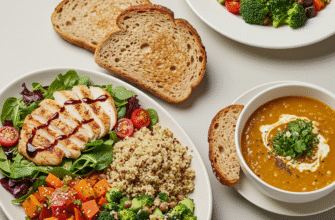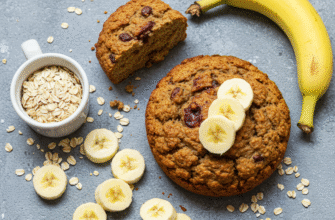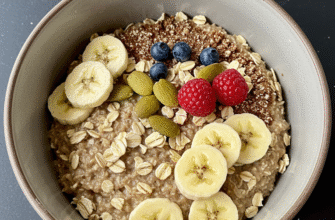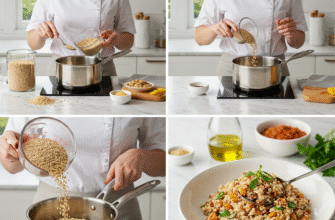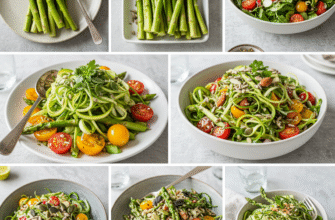Thinking ahead about unexpected situations isn’t about dwelling on the worst-case scenarios; it’s about practical self-reliance and securing peace of mind. Whether it’s a power outage lasting a few days, a sudden job loss, or simply being snowed in, having a well-stocked pantry can make a significant difference. But just having *any* food isn’t enough. Focusing on stocking a healthy pantry ensures that during potentially stressful times, your body gets the sustained energy and nutrients it needs to cope, rather than relying on sugary snacks and processed meals that lead to energy crashes and offer little nutritional value.
Why Prioritize Health in Your Emergency Pantry?
During emergencies, stress levels can naturally rise. Good nutrition plays a vital role in supporting not just physical energy but also mental clarity and mood regulation. Relying solely on high-sodium, low-fiber convenience foods can leave you feeling sluggish, irritable, and less equipped to handle the situation. A pantry stocked with wholesome, nutrient-dense foods provides:
- Sustained Energy: Complex carbohydrates, lean proteins, and healthy fats provide fuel that lasts, unlike the quick spike and crash from simple sugars.
- Better Mood and Focus: Nutrients support brain function and can help mitigate the effects of stress.
- Stronger Immunity: While pantry foods might not be farm-fresh, choosing nutrient-rich options helps support your immune system when you might need it most.
- Digestive Health: Fiber-rich foods like whole grains, beans, and some canned vegetables aid digestion, which can often be disrupted by stress.
Building this kind of pantry doesn’t require a massive upfront investment or specialized survivalist gear. It’s about making smart, gradual choices focused on shelf-stable, versatile, and nourishing foods.
Laying the Foundation: Core Staples
Every healthy emergency pantry starts with the basics. These are the versatile, long-lasting items that form the backbone of many potential meals.
H3>Water: The Undisputed Champion
Before even thinking about food, ensure you have adequate water. Humans can survive much longer without food than without water. Aim for at least one gallon of water per person, per day, for a minimum of three days, though aiming for a week or two provides a greater buffer. Consider commercially bottled water, which has a long shelf life (check dates), or methods for storing and purifying tap water if that’s more feasible for you. Water purification tablets or a high-quality water filter are also excellent additions.
H3>Whole Grains for Lasting Energy
Forget the refined white bread and pasta if you can. Whole grains offer complex carbohydrates, fiber, and essential nutrients. They digest more slowly, providing steady energy.
- Brown Rice: More nutritious than white rice, although it has a slightly shorter shelf life due to its natural oils (store properly!).
- Rolled Oats: Extremely versatile for breakfast, adding to baked goods (if you have a non-electric cooking method), or even savory applications.
- Quinoa: A complete protein, cooks relatively quickly, and is nutrient-dense.
- Whole Wheat Pasta: Offers more fiber than traditional white pasta.
- Barley: Hearty and great in soups or stews.
- Popcorn Kernels: A whole grain snack that stores well and can be cooked easily (even over a camping stove).
Store grains in airtight containers in a cool, dark place to maximize freshness and deter pests.
H3>Legumes: Protein and Fiber Powerhouses
Beans, lentils, and peas are nutritional superstars. They are packed with protein, fiber, iron, and other minerals. They are also incredibly cheap and store for a very long time, especially in their dried form.
- Dried Beans: Kidney, black, pinto, navy, garbanzo – the variety is endless. They require soaking and longer cooking times but are cost-effective.
- Dried Lentils: Red, brown, green – lentils cook much faster than dried beans and don’t usually require soaking.
- Canned Beans: Convenient and ready-to-eat. Opt for low-sodium versions whenever possible and rinse them before use to remove excess salt.
Adding Variety: Canned & Jarred Goods
The canning process preserves food for long periods, making canned goods essential for an emergency pantry. Focus on variety to ensure a broader range of nutrients and prevent palate fatigue.
H3>Vegetables
Look for low-sodium or no-salt-added options. While not as crisp as fresh, canned vegetables retain many nutrients.
- Tomatoes (diced, crushed, paste): Incredibly versatile for sauces, soups, and stews.
- Corn and Peas: Familiar favorites, add sweetness and texture.
- Green Beans: A good source of fiber.
- Carrots and Potatoes: Heartier options.
- Mixed Vegetables: Convenient blend for soups or side dishes.
H3>Fruits
Choose fruits packed in their own juice or water, not heavy syrup, to avoid excessive added sugar.
- Peaches, Pears, Pineapple Chunks: Offer sweetness and vitamins.
- Applesauce (unsweetened): Easy to eat, requires no preparation.
- Mandarin Oranges: A good source of Vitamin C.
H3>Proteins
Beyond beans, canned meats and fish provide essential protein.
- Tuna and Salmon (packed in water): Excellent sources of protein and omega-3 fatty acids. Look for sustainably sourced options if possible. Pouches often have a longer shelf life and are lighter than cans.
- Canned Chicken or Turkey: Useful for adding to soups, salads (if you have shelf-stable mayo), or eating plain.
- Sardines: Nutrient-dense, packed with calcium and omega-3s.
Healthy Fats, Nuts, and Seeds
Healthy fats are crucial for satiety, hormone production, and absorbing certain vitamins. Nuts and seeds are great sources, along with shelf-stable oils.
- Nuts: Almonds, walnuts, cashews, pecans. Buy unsalted if possible. Store in airtight containers, potentially in the freezer for long-term storage to prevent the oils from going rancid.
- Seeds: Chia seeds, flax seeds, sunflower seeds, pumpkin seeds. Offer fiber, protein, and healthy fats.
- Nut Butters: Peanut butter, almond butter, sunflower seed butter. Choose natural varieties with minimal added sugar and oils. Check expiration dates, as natural oils can separate and eventually spoil.
- Shelf-Stable Oils: Olive oil, coconut oil, avocado oil. Necessary for cooking and adding flavor/fat. Store in a cool, dark place. Smaller bottles might be better to prevent large quantities from going rancid after opening if used infrequently.
Don’t Forget Flavor and Comfort
Eating basic staples day after day can become demoralizing. Simple additions can make a huge difference in palatability.
- Spices and Herbs: Salt, pepper, garlic powder, onion powder, chili powder, cumin, oregano, basil, cinnamon – whatever you use regularly. They take up little space but add immense flavor.
- Broth/Bouillon: Cubes, powders, or cartons of chicken, beef, or vegetable broth add depth to soups, stews, rice, and grains. Look for low-sodium options.
- Sweeteners: Honey and maple syrup have very long shelf lives. Sugar also stores indefinitely if kept dry.
- Comfort Items: Instant coffee, tea bags, cocoa powder can be morale boosters. Consider some dark chocolate (high cacao content) for a healthier treat.
- Condiments: Shelf-stable condiments like mustard, vinegar, hot sauce, soy sauce can liven up meals. Check expiry dates after opening if refrigeration is normally required.
Check Your Stock Regularly! Set a reminder every 6 months to check expiration dates on all your emergency supplies. Use the ‘First-In, First-Out’ (FIFO) principle – place newer items at the back and older items at the front. Actively incorporate items nearing their expiration date into your regular meals and replace them on your next shopping trip. This prevents waste and ensures your emergency food is always fresh and safe to eat.
Building and Maintaining Your Stockpile Wisely
Creating a healthy emergency pantry is a marathon, not a sprint. Here’s how to approach it:
- Start Small, Be Consistent: You don’t need to buy everything at once. Add one or two extra shelf-stable items to your regular grocery cart each week or month. Focus on foods your household already eats and enjoys.
- Rotate, Rotate, Rotate: As mentioned in the check block, rotation is key. Don’t let your emergency food expire untouched. Integrate it into your meal planning. This also helps you stay familiar with cooking and preparing these foods.
- Consider Dietary Needs: Account for allergies (gluten, nuts, dairy), intolerances, medical dietary restrictions, and even strong preferences within your household. Stocking food nobody can or will eat is pointless. Include options for babies, toddlers, or elderly family members if applicable.
- Storage Location Matters: Choose a cool, dark, dry location for your pantry items. Basements, closets, or under beds can work. Avoid areas with temperature fluctuations, like garages or attics, if possible. Moisture and heat are enemies of shelf life.
- Use Appropriate Containers: For bulk items like rice, beans, oats, transfer them from their original packaging into airtight food-grade containers (buckets, jars) to protect against pests, moisture, and oxygen. Label everything clearly with the contents and the purchase or expiration date.
- Remember Non-Food Items: While focusing on food, remember essentials often stored nearby: a manual can opener, basic cooking utensils, fuel for cooking if the power goes out (camping stove, grill), matches/lighters, basic first-aid supplies, medications, flashlights, and batteries.
A Prepared Pantry is a Healthy Pantry
Stocking a healthy pantry for emergencies is an act of practical foresight. It’s about ensuring that, should you need to rely on your stored supplies, you have access to nourishing food that supports your well-being during a challenging time. By focusing on nutrient-dense staples, practicing rotation, and considering your household’s specific needs, you can build a reliable resource that provides not just sustenance, but also comfort and peace of mind. It’s a gradual process, but the security it offers is well worth the effort.


